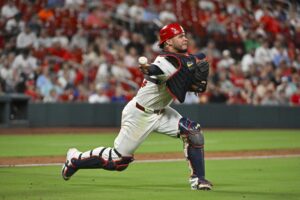When young flamethrower Jordan Hicks went down with an elbow injury near the end of June 2019, Mike Shildt made it clear that the closer role was up for grabs. Many expected the red-hot John Gant or John Brebbia to fill the spot. However, the return of former no. 1 starter Carlos Martinez from injury in late May came at the perfect time. Martinez was a saving grace at the back end of the St. Louis Cardinals bullpen, part of a pitching staff that carried an often lackluster offense all the way to the NLCS.
Despite Martinez’s success, his 2019 campaign was not without obstacles. “Cardiac Carlos” made a habit of issuing bad walks and sometimes missing his spots by a wide margin. Oftentimes, this led to close calls when it came to finishing off games, giving Cards fans
flashbacks of Trevor Rosenthal’s walk-walk-walk, strikeout-strikeout-strikeout saves.
His inconsistency culminated in a disastrous NLDS against the Atlanta Braves. Martinez nearly surrendered a four-run ninth-inning lead in Game 1, then blew a save in Game 3 that put St. Louis on the brink of elimination. There is no doubt he has the stuff to win a starting role in 2020, but the consistency questions remain.
2019 Recap
The Positives
When Carlos Martinez took over as full-time closer around the All-Star Break, many were skeptical. Shoulder problems, possibly due to Martinez’s neglect of offseason throwing, had kept him out until late May, limiting his opportunities to that point. However, the 27-year-old from the Dominican Republic put the doubters to rest quickly.
Even with St. Louis struggling to build late leads, Martinez led the league in saves over the season’s second half with 21. Much of his success was reliant on keeping the ball in play, to the tune of just a 5.7% HR/FB rate, according to Fangraphs. This ranked 7th in the majors from his debut on, and 2nd on the team behind Brebbia. He especially dominated in June, posting 13 strikeouts in 11 ⅔ innings with a minuscule 0.857 WHIP.
When he did get himself into trouble, a conference with veteran catcher Yadier Molina usually helped him lock-in. Martinez used that focus to strike out 26.7% of hitters with multiple men on base, according to Baseball-Reference.
His calling card has always been his high-octane fastball, which in 2019 averaged 96.6 MPH. The pitch plays especially well up in the zone and is deadly when located well. Martinez’s changeup also has shown signs of greatness in recent years, with +5.3 inches of vertical movement* and an expected slugging percentage (xSLG) of only .174 per Baseball Savant. When he locates his pitches, Martinez’s arsenal is up there with the best.
The Negatives
Carlos Martinez has always been known for throwing hard, but his four-seamer has not been quite as effective in recent years. In 2019, it was his hardest-hit pitch, with an average exit velocity of 90.4 MPH. The issue was not his velocity, as 96.6 MPH puts him well above average, but rather a newer measurement: spin rate.
According to Statcast, Martinez’s fastball spun at an average of 2125 RPM, which sat in only the 13th percentile of baseball. His high-80s slider did generate a good amount of pop-ups, but Martinez had trouble finishing through the pitch consistently. If he cannot fix that in 2020, his hanging breaking balls will be hit hard and often.
His awful Divisional Series against Atlanta also soured many fans’ opinions of him. In Game 1, Martinez nearly blew a four-run lead in the ninth with home runs off the bats of Ronald Acuña and Freddie Freeman. And in a tight Game 3, clutch hits from Dansby Swanson and Adam Duvall led the Braves to a ninth-inning comeback. As a result, Martinez was thrown to the back of the line for bullpen duty and pitched just ⅓ of an inning against the Washington Nationals in the NLCS.
2020 Outlook
Although Carlos Martinez has been a starter for his entire career up until 2018, his future role is up for debate. Some in Martinez’s camp are under the impression that he wants to stay in a bullpen role for his long-term health. With the crop of starting pitchers at Mike Shildt’s disposal, that could work out very well.
A rotation of Miles Mikolas, Jack Flaherty, Adam Wainwright, Dakota Hudson, and the newly signed Kwang-Hyun Kim would leave Martinez with the opportunity to stay in the bullpen. With the long delay in starting the 2020 campaign, it is also possible that Jordan Hicks could return right around Opening Day. Assuming Hicks takes over the closer role again, Martinez could fall into a long-relief spot, similar to Michael Wacha and Ryan Helsley in 2019.
This would likely leave Hicks, Gant, Brebbia, Helsley, Giovanny Gallegos, Tyler Webb, and Andrew Miller with the late-inning work, a long list of relievers that could shut down any lineup. Hopefully, Shildt realizes the potential he has in Martinez and can find him a prominent role on the Cardinals’ 2020 staff.
*Vertical and horizontal movement of pitches is measured relative to the league-wide average. Thus, “+5.3 inches” means the pitch moved 5.3 inches more than the average pitch, not just 5.3 inches.
Sources: Baseball-Reference, Fangraphs, Baseball Savant, Statcast
Main Image
Embed from Getty Images






